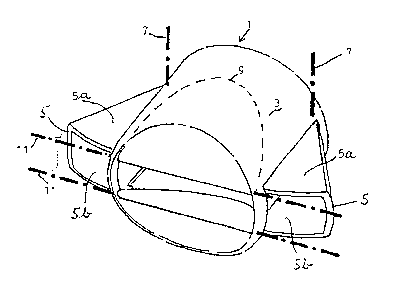Some of the information on this Web page has been provided by external sources. The Government of Canada is not responsible for the accuracy, reliability or currency of the information supplied by external sources. Users wishing to rely upon this information should consult directly with the source of the information. Content provided by external sources is not subject to official languages, privacy and accessibility requirements.
Any discrepancies in the text and image of the Claims and Abstract are due to differing posting times. Text of the Claims and Abstract are posted:
| (12) Patent Application: | (11) CA 2352119 |
|---|---|
| (54) English Title: | HAIRDRYER NOZZLE WITH VARIABLE CONFIGURATION |
| (54) French Title: | EMBOUT DE SECHE-CHEVEUX A CONFIGURATION VARIABLE |
| Status: | Deemed Abandoned and Beyond the Period of Reinstatement - Pending Response to Notice of Disregarded Communication |
| (51) International Patent Classification (IPC): |
|
|---|---|
| (72) Inventors : |
|
| (73) Owners : |
|
| (71) Applicants : |
|
| (74) Agent: | GOWLING WLG (CANADA) LLP |
| (74) Associate agent: | |
| (45) Issued: | |
| (86) PCT Filing Date: | 1999-12-07 |
| (87) Open to Public Inspection: | 2000-06-15 |
| Availability of licence: | N/A |
| Dedicated to the Public: | N/A |
| (25) Language of filing: | English |
| Patent Cooperation Treaty (PCT): | Yes |
|---|---|
| (86) PCT Filing Number: | PCT/BE1999/000160 |
| (87) International Publication Number: | BE1999000160 |
| (85) National Entry: | 2001-05-25 |
| (30) Application Priority Data: | ||||||
|---|---|---|---|---|---|---|
|
The invention concerns a nozzle, detachable or not, designed for a hairdryer,
which can be easily modified from a first configuration supplying a hot air
stream with a substantially circular cross-section to obtain an air stream
substantially rectangular, that is wide and flat, in cross-section. Said
nozzle consists of a ferrule (3) provided with two slots (5) capable of
pivoting relatively to geometrical axes (7) and flaps (9) capable of producing
a pivoting motion relatively to geometrical axes (11) perpendicular to the
pivot pins (7) of the slots (5).
Embout, amovible ou non, destiné à un sèche-cheveux, qui peut être modifié aisément depuis une première configuration fournissant un flux d'air chaud présentant une section sensiblement ronde, jusqu'à l'obtention d'un flux d'air à section sensiblement rectangulaire, c'est-à-dire large et plate. Cet embout est constitué par une virole (3), équipée de deux tiroirs (5) pouvant effectuer un mouvement de pivotement axial par rapport à des axes géométriques (7) et de volets (9) pouvant effectuer un mouvement de pivotement par rapport à des axes géométriques (11) perpendiculaires aux axes de pivotement (7) des tiroirs (5).
Note: Claims are shown in the official language in which they were submitted.
Note: Descriptions are shown in the official language in which they were submitted.

2024-08-01:As part of the Next Generation Patents (NGP) transition, the Canadian Patents Database (CPD) now contains a more detailed Event History, which replicates the Event Log of our new back-office solution.
Please note that "Inactive:" events refers to events no longer in use in our new back-office solution.
For a clearer understanding of the status of the application/patent presented on this page, the site Disclaimer , as well as the definitions for Patent , Event History , Maintenance Fee and Payment History should be consulted.
| Description | Date |
|---|---|
| Inactive: IPRP received | 2008-01-10 |
| Application Not Reinstated by Deadline | 2004-12-07 |
| Time Limit for Reversal Expired | 2004-12-07 |
| Deemed Abandoned - Failure to Respond to Maintenance Fee Notice | 2003-12-08 |
| Inactive: Cover page published | 2001-09-24 |
| Letter Sent | 2001-09-19 |
| Inactive: First IPC assigned | 2001-08-26 |
| Inactive: Single transfer | 2001-08-14 |
| Inactive: Courtesy letter - Evidence | 2001-08-07 |
| Inactive: Notice - National entry - No RFE | 2001-08-01 |
| Application Received - PCT | 2001-07-27 |
| Application Published (Open to Public Inspection) | 2000-06-15 |
| Abandonment Date | Reason | Reinstatement Date |
|---|---|---|
| 2003-12-08 |
The last payment was received on 2002-12-06
Note : If the full payment has not been received on or before the date indicated, a further fee may be required which may be one of the following
Patent fees are adjusted on the 1st of January every year. The amounts above are the current amounts if received by December 31 of the current year.
Please refer to the CIPO
Patent Fees
web page to see all current fee amounts.
| Fee Type | Anniversary Year | Due Date | Paid Date |
|---|---|---|---|
| Basic national fee - standard | 2001-05-25 | ||
| Registration of a document | 2001-08-14 | ||
| MF (application, 2nd anniv.) - standard | 02 | 2001-12-07 | 2001-10-04 |
| MF (application, 3rd anniv.) - standard | 03 | 2002-12-09 | 2002-12-06 |
Note: Records showing the ownership history in alphabetical order.
| Current Owners on Record |
|---|
| FACO S.A. |
| Past Owners on Record |
|---|
| HENRI SMAL |